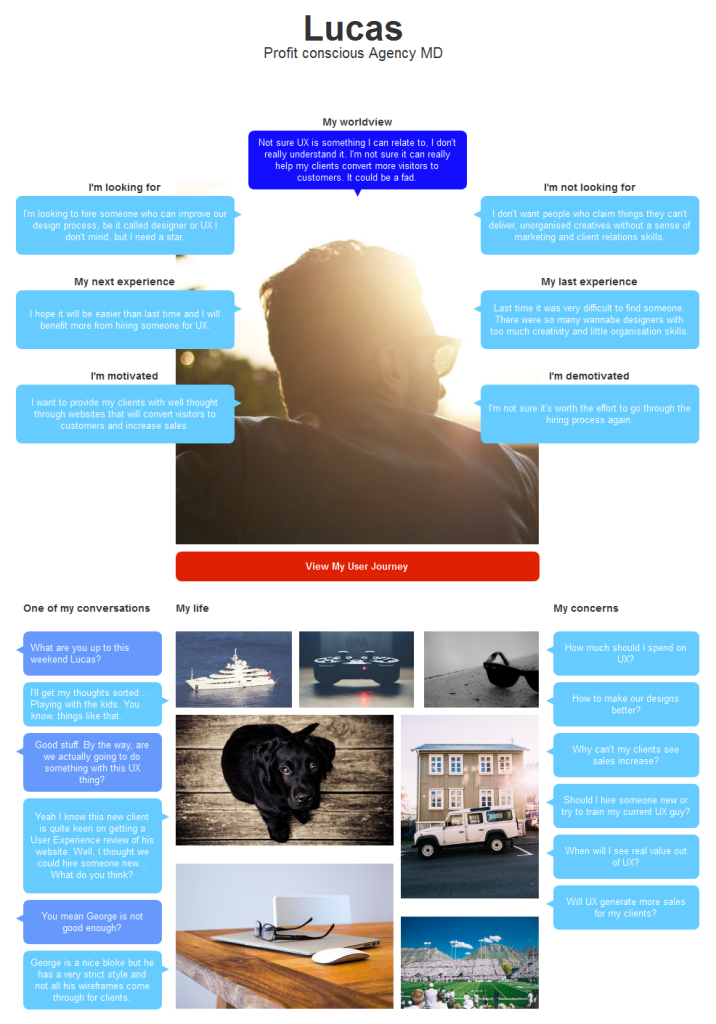Personas are essential when you are working on a project and don’t know the target audience very well. For instance, not every designer has experience in fashion or banking. Creating a model of your target audience may help you and your stakeholders feel significantly more empathy for those people.
Personas can also help you get out of the mindset of thinking about users abstractly. “User” sounds like it does not refer to real people who have desires, concerns, past experiences. When real people use your app or website, they are there to reach their goals: to buy something, to research, to register for something they need, or to get information. How can we design something helpful for them without feeling empathy?
Thinking about users as “just users” is just plain harmful. Empathy for the real people who use the website or app, on the other hand, is essential. If we have empathy, we will not design something that would make these people feel trapped, cheated, or confused.
Humane personas
Using personas enables us to feel more empathy by creating a life-like humans we want to make happy. The problem is, most personas are not designed to make the reader care about the person. Most of them look like dossiers: name, occupation, age, sex, some descriptive text, and a Google image search photo. Why would anyone care about a persona that looks like a PowerPoint slide?

We should also always keep in mind that stakeholders are also “users.” We have to make our deliverables real easy for them to understand.
I wondered: What would make my personas more humane? The bullet-point personas really made me feel ashamed as a designer. I was sure that these deliverables would not reach their desired goal which is to put me and my stakeholders into the mind of the people who use their web site. So why do them that way?
Making life-like personas
I started to look for a solution. As a good UX designer should, I did some Google searching, sketched, and then fleshed it out. I went through many versions until I found one I was happy with, and response from project teams seems to be positive. I think these deliverables can be developed further, though. I call the result the Humane Speech Bubble Persona.
Where a traditional persona would list attributes in bullet points, I had the persona tell his own story, in speech bubbles.

The key bubble is the worldview. It represents the central attribute that tells us who our person is, summarizing the person in a single bubble.

Then I added bubbles with attributes like “motivation,” “looking for…,” and “desired experience,“ which help us focus on the goals of the person. Adding the opposite of these, such as “demotivation,” “not looking for,” and “last experience,” is also beneficial. Finally, I added the persona’s questions. This helps us focus on the needs and concerns of the user.
The unsolicited insight that comes from an overheard conversation means you get useful information that wasn’t meant for you. The bubbles recreate that experience for the users of the persona.
Presenting text attributes in speech bubbles make the persona humane as well. Speech bubbles show the person speaking, in easy-to-follow sound bites. This makes the persona scannable and adds some fun to the deliverable.
Finally, to make the persona more scannable and relatable, I added pictures from the persona’s imaginary life to help us visualize the persona as a human being. The pictures represent both current as well as desired objects that the persona cares about. As well, when personas are hanging on a far-off wall, they provide an easy way to remember who this persona is, and what he really cares about. No reading necessary!
Conclusion
Making personas humane not only benefits you, the UX designer, but your stakeholders as well. Adding flavor to deliverables does not take a lot of effort, so why not do it? A humane persona will help us feel empathy for the real people who will use our designs and will help stakeholders accept concepts readily. Try out the Humane Speech Bubble Persona, and let me know what you think!
For some more insight how I made this persona template, read my article on my website.

Very nice article!
It is useless to create a persona that does not bring real benefits to the project. Congratulations on the concept, I will use it going forward.
To get the benefits personas have to have personas have to be rich, significant and as detailed as the project and the team need them to breathe life into personas.
In order personas can and should be use all over project phase. Personas need to accurately represent the users the team is aiming for. And they need to have a solid foundation in the experiences of real users to be believable and meaningful.
And the completeness should serve the team in every project stage even if not every detail is needed in every stage and every team member.
Perhaps it might be helpful for one or two know how to utilize personas throughout the stages of the project
http://ux4dotcom.blogspot.de/2009/10/why-personas-matter.html.
Thanks for this great article – good job.
The speech bubble idea is well worth adopting, so I shall.
On a matter of language, you said “I wondered: What would make my personas more humane?” Humane or human? I think you mean human, not humane ?
Some interesting thoughts, thanks.
Where did the overheard discussion details originate from?
Some interesting thoughts, thanks.
Where did the overheard discussion details originate from?
As we’re going to redefine our persona right now, I find this article interesting. We will put something else instead of our Simpsons faces (funny yes but not so useful).
“How to Breathe Life Into Personas” is the nice article to read, i ever read like this but this is more informative
Different persspetive to “Personas”…good one